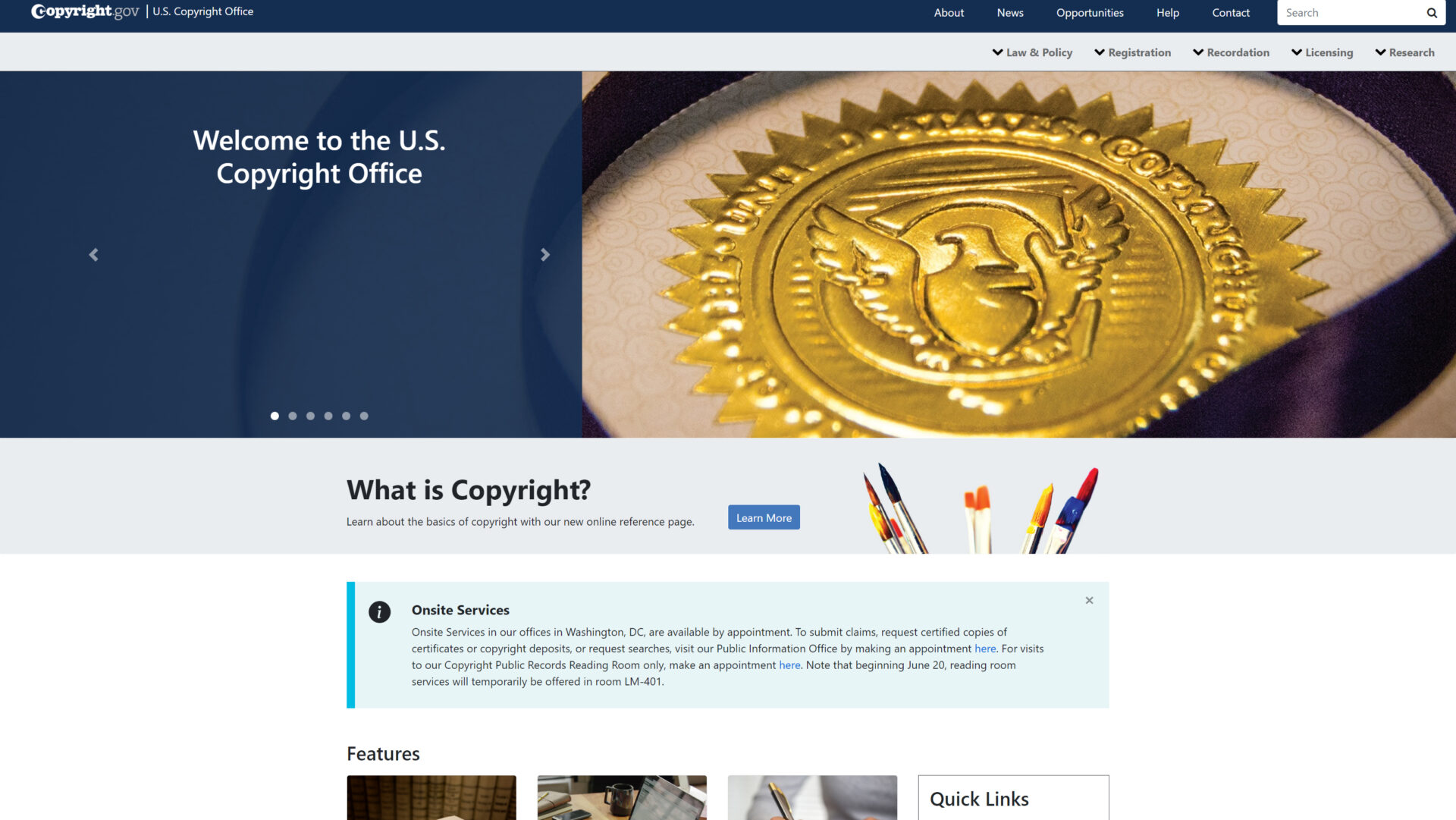Protecting your intellectual property should be a priority for any creative person. Fortunately, maintaining control over your creative work is simple thanks to a legal protection called copyright. With the help of entertainment attorney Larry Zerner, we’ll explain what copyright is, how it works and how you can copyright your video or other creative work.
Let’s dive in.
What is copyright?
Copyright refers to a person’s right to protect their creative works from infringement — that is, being copied, adapted or distributed without permission from the creator. This right is guaranteed in the U.S. Constitution under Article I, Section 8, clause 8, which gives Congress the power “to promote the Progress of Science and useful Arts, by securing for limited Times to Authors and Inventors the exclusive Right to their respective Writings and Discoveries.”
Protected works include literary works, software, musical works and accompanying words or lyrics, dramatic works, pantomimes and choreographic works, pictorial, graphic, and sculptural works, motion pictures and other audiovisual works, sound recordings and architectural works.
These days, such works are automatically protected by copyright law: “As soon as you create it, it is protected by copyright,” Larry Zerner tells us. Zerner has been practicing entertainment and copyright law in Los Angeles for more than 30 years. Even though your work is automatically protected under current copyright law, he emphasizes the importance of registering your work with the U.S. Copyright Office. When asked about the best way to make sure your content is protected, Zerner doesn’t hesitate:
“There’s only one thing to do. It’s just register with the Copyright Office. There’s no other — no other choice.”
The history of U.S. copyright law
Of course, at the time the Copyright Office was created in 1800, you couldn’t register software, motion pictures or even sound recordings. Likewise, the process of securing copyright protection has also changed drastically over the years.
The Copyright Office became a separate department of the Library of Congress in 1897. Since then, as technology developed, the Copyright Act has been and continues to be amended to include more and more types of protectable works. Copyright is an important piece of video production and the law.
Along with allowing more types of protectable works, the U.S. Copyright Office has also modified its rules for registering creative works over time. Originally, the term of copyright protection was 14 years, which could be extended an additional 14 years. Due to changes in the law, in most of the 20th century, a work could be protected for 28 years once a copy of it — a “fixed copy,” as opposed to a delivered speech, for example — was deposited with the Copyright Office and a notice was affixed to the work. The notice includes the word “Copyright” or the abbreviation “Copr.” or the encircled c symbol © and the creator’s name and year date. The registration could be extended an additional 28 years when the holder filed appropriate papers in the Copyright Office during the 28th year after registration.
Congress made very significant changes to the law in 1976 that went into effect on January 1, 1978. Under this most recent law, protection is less complicated than under earlier laws and procedures. The U.S. copyright law is also more compatible with most other countries’ laws now.
How long does copyright last?
The copyright term is no longer 28 years and is no longer renewable. Under the present law, the term is measured from the author’s life plus 70 years for a natural person. For a company, the term will last for 95 years.
In addition, the creator of the material needs no longer to deposit a copy of the work in the Copyright Office and, in fact, no longer has to affix a notice to the work at all. However, it’s advisable to do both. Therefore, even if you do not register your video in the Copyright Office, it is now protected under federal law for your life plus 70 years.
Benefits of registering

“Ostensibly, you’re protected by copyright protection at the moment of creation. As soon as you have it, you are protected,” Zerner says. So why, then, does he still recommend registering your work with the U.S. Copyright Office? As it turns out, registering your work offers several legal advantages if it’s ever infringed upon.
Registration is required to file a lawsuit
First of all, as of 2019, you are required to have registration before you file a copyright lawsuit. “In the old days, prior to 2019,” Zerner explains, “you could file right before suing, and at least in some circuits, they would say, ‘Okay, well, as long as it’s in the process, okay.’ But now you actually have to have the certificate.”
And this isn’t the only reason to register your work in a timely manner.
You can include attorney fees in your lawsuit
Under U.S. law, you can only be awarded attorney fees if you prevail in your copyright lawsuit if you completed registration prior to the date of infringement or within 90 days of the work’s first publication.
Zerner gives an example: “So you put a video on YouTube, and you don’t register it, and 91 days later someone copies it … and you wanna file a lawsuit. You can say, ‘Okay, now I’m gonna register it,’ wait for the registration to come through — which will take a few months — and then file a lawsuit. But you don’t get attorneys fees in that lawsuit.”
Zerner points out that, in the scheme of things, such a lawsuit would likely not award a substantial amount of money. “That lawsuit is never gonna go,” he warns,” because … you’ll spend more on attorney’s fees than you would [get], maybe, in recovery.”
Actual vs. statutory damages
Here’s another big benefit. Under the Copyright Act, you are entitled to be awarded either your actual damages or statutory damages. Actual damages include your lost profits and the profits of the infringers that are attributable to the work. When you register your work, you gain the option to claim statutory damages for infringement — up to $150,000 — against an infringer without showing actual damages.
Zerner gives another example: “You got a tape of a plane crash or a car crash. And you put it out, and then someone uses it and sells it … Well, in theory, you can sue … and if you’re registered prior to the infringement, you can ask for statutory damages. And that’s what we talk about where a jury can give you up to anywhere between $750 and $30,000, or if it concludes the infringement was willful, you could get up to $150,000. And that’s where people talk about the $150,000.”
“I get a lot of cases … from like a photographer whose work was used by somebody in a way that if they came to him for a license, it would’ve been a $1,000 or less.” In this example, the actual damages don’t amount to much. “But because it’s willful infringement,” Zerner says, “… you may have to pay us $150,000.” However, he says it’s common for people to overestimate the potential payout of their infringement case. “Right now, [that $150,000 payout] is probably not gonna happen. But the law just says you’ve got this range. It could be $750; it could be $150,000. You don’t know.” While not guaranteed, these high potential damages can “stop a lot of things before they start,” Zerner concludes.
Presumed validity
Sometimes, infringement happens years or decades after the work was produced. In these cases, having registered your work in a timely manner will give you the advantage of presumed validity.
“If [the work is] registered within five years of its creation, then there is a presumption that the registration is valid and you own the copyright,” says Zerner. “If you don’t — if you wait more than five years — you no longer have that presumption and you have to prove that you created it. ’Cause how do they know that you were the one who shot that video?”
Providing that proof can sometimes be difficult, if not impossible. “We’ve learned over the past, you know, certainly in my lifetime, the method of filmmakers … It keeps changing … if I said, ‘Oh, find that old VHS tape that you shot the video from 1989 on’ … You couldn’t do it. You don’t have it.” In this case, simply registering your work within five years of creation could save you a ton of hassle.
International protection
Finally, copyright protection, unlike patent or trademark protection, is not territorial; it is international. The Berne Convention is an international treaty for countries that participate in it. Today, including the United States, there are 181 parties to the Berne Convention: 178 United Nations member states plus the Cook Islands, the Holy See and Niue. The Berne Convention requires its signatories to treat the copyright of works of authors from other signatory countries at least as well as those of its own nationals.
In the U.S., that means another party is legally prevented from reproducing, distributing, displaying or performing the protected work, or from making another work derived from the copyrighted work (i.e., derivative works) without permission of the holder.
A registered copyright is, therefore, one of the best legal bargains available: worldwide protection for your work is available for $65.
No excuse not to register
Hopefully, you are now convinced of the importance of registering your work with the U.S. Copyright Office. Zerner emphasizes, “It’s really important to have registered prior to the infringement because you get all these benefits. These benefits do not accrue unless you have your registration before the infringement.”
Old myths die hard
One of the techniques people used before the 1976 Copyright Act, in order to save the $6.00 copyright registration fee at the time, was to mail themselves the material they wished to protect and not open the envelope when the post office delivered it to them. They believed — erroneously — that such a process would constitute copyright protection. What is required now to prove copyright protection, if you do not have an official registration from the Copyright Office, is your date of creation of the work. Accordingly, various date-stamped mechanisms can help prove your date of creation, such as YouTube videos, email correspondence with attachments, etc.
Needless to say, however, registration is the preferred method to establish your copyright rights.
How to register your work

Conveniently, you can register your work with the U.S. Copyright Office online at www.copyright.gov. The fee for a standard registration filing is $65. The average processing time for most registrations is 2.1 months.
Here’s what you’ll need to do:
- Provide all required information on the application form
- Pay the required fee online via Pay.gov (a deposit account option is available for frequent users)
- Upload or mail in a copy of your work
To get started, head to www.copyright.gov. At the top of the site, click on “Registration” and select “Register Your Work: Registration Portal.” Then, click on the button labeled “Log in to the Electronic Copyright Office (eCO)” and follow the instructions to log in or register a new account. Once inside the Registration Portal, select the appropriate option under “Register a Work” from the left sidebar. As you complete the application, remember to read all instructions carefully to avoid delays in your registration.
Registering groups of videos
If you have a large number of works that you would like to register, the Registration Portal allows you to register up to 10 unpublished works at a time using the Group of Unpublished Work application. Just make sure to select the correct application option.
Protect your work
Copyright is a valuable protection for anyone producing creative work. It has gone through several iterations over the decades, but today, copyright law protects a work for the life of the creator, plus 70 years. Though your video or other work is technically protected by copyright from the moment of creation, it’s still important to register your work with the U.S. Copyright Office. If you are ever unfortunate enough to be a victim of infringement, you’ll be happy you did.
To learn more about copyright law or register your creative work, head over to www.copyright.gov.
Contributing editors for this article include Nicole LaJeunesse and Mark Levy.







